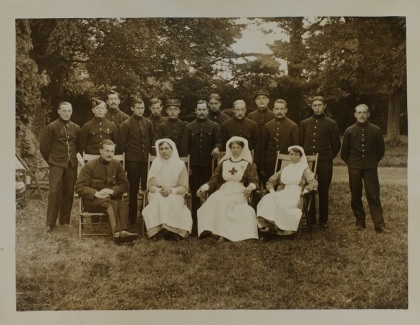Today marks International Women’s Day which celebrates the social, economic, cultural and political achievements of women throughout history and across nations. The Special Collections at the University of Southampton holds material for a range of women whose contribution in many spheres is worthy of mention. For this blog post we will focus on Gladys Helen Rachel Montagu, Baroness Swaythling (MS 383).
Born in Belfast, Northern Ireland, in 1879, she was the eldest daughter of Colonel Albert Edward Williamson Goldsmid, MVO, and Ida Stewart Beauclerk Hendricks. In 1898 she married Louis Montagu, the eldest son of Samuel Montagu, first Baron Swaythling (MS 117), founder of the banking firm Samuel Montagu and Company. Louis succeeded as second Baron Swaythling in 1911 and inherited the office of president of the Federation of Synagogues (MS 248), an organisation created by his father to promote the acculturation of Jewish immigrants.
Following their marriage they lived at Townhill Park House, Southampton, purchased by the first Baron Swaythling in 1897. Originally dating from the 1790s, they had the house extended and re-designed by architect Leonard Rome Guthrie in the Italianate style. Guthrie also designed the terraced gardens to complement the style of the house, with the plants laid out by the renowned garden designer Gertrude Jekyll. As Lord and Lady Swaythling they were leading members of the Anglo-Jewish community and leading figures in English society, hosting dinner parties and other social events at Townhill Park where visitors included Princess Alice and Queen Mary (with whom Lady Swaythling had a lifelong friendship).
They were also active communal workers, with Lady Swaythling applying much of her energy to the local Southampton area. During the First World War she became President of the Women’s Southampton branches of the Auxiliary of the YMCA and Women’s Emergency Corps, as well as the War Hospital Supply Depot, Southampton. In addition, she served on eighteen different committees, including as chair of the Wounded Allies Relief Committee, established for the provision of convalescent homes for wounded Belgian soldiers.
Country houses were required for medical use as the large numbers of wounded meant there were not enough hospitals able to cope with the seriously disabled or even those simply convalescing. These houses were pressed into service or were donated for the purpose, as their clean country air and fine grounds were considered most helpful to rest and recuperation. Allington Manor, a country house in Eastleigh owned by the Swaythlings, was one of the houses donated as a military sanitorium. Lady Swaythling took a deep interest in the welfare of the sanatorium and would sing to the patients during her visits. Later, she was involved in organising hospitality for American soldiers and sailors, with her efforts leading to her becoming known as the “British godmother” among American naval enlisted men. Other activities included working on the executive committee of Queen Mary’s Governess’ Home in Surrey, and assisting the British Women’s Patriotic League.
![Certificate granted to Lady Swaythling [MS 383 A4000/2/1]](https://specialcollectionsuniversityofsouthampton.files.wordpress.com/2017/03/red-cross-award.jpg?w=380&h=278)
Certificate granted to Lady Swaythling in recognition of her
charitable services during the First World War [MS 383 A4000/2/1]
After the war she continued her communal actives, with her roles including President of the Southampton Hostel for Unmarried Women and the Southampton branches of the National Society for Combating Venereal Diseases and the University Extension Lectures movement. She was also chair of the conjoint committee of the British Red Cross and the Order of St John of Jerusalem. In 1919 she joined the Council of the Anglo-Belgian Union and continued to support Belgian exiles during the Second World War. She was an active supporter of refugees throughout her life and, in 1925, addressed a letter to President Coolidge pleading for the admission to the United States of Jewish refugees stranded in Southampton.
Other public offices she held included President of the Electrical Association for Women, established in 1924 to interest women in the electrical development of the country; Honorary President of the Jewish Lads’ Brigade (MS 244), a Jewish youth organisation founded by her father in 1895; President of the Southampton branch of the Girl Guides Association; and Vice-President of the NSPCC (National Society for the Prevention of Cruelty to Children). She travelled widely, touring countries such as India, Australia, China, Japan, the United States, and Canada, and was the recipient of many overseas honours. She was made OBE in 1953.
Lord and Lady Swaythling had had three sons and a daughter. Their eldest son Stuart became the third Lord Swaythling in 1927 on Louis’ death. The family continued to live at Townhill Park until 1939 when the house was handed over to the Red Cross and used as a convalescent home for British and American soldiers during the Second World war. Lady Swaythling died in 1965 at the age of 85.
This year, Southampton is joining in the International Women’s Day (IWD) celebration theme by ‘Being Bold’ and inviting everyone to West Quay and fringe events in town on Saturday March 11 to promote and celebrate the social, economic, cultural and political achievements of women, both locally and worldwide. For further details visit:
https://www.southampton.ac.uk/blog/sussed-news/2017/02/28/celebrate-international-womens-day-on-11-march/

![Photograph of Gladys, Dowager Lady Swaythling, taken by Dorothy Wilding [MS 383 A4000/6/1/5 f2]](https://specialcollectionsuniversityofsouthampton.files.wordpress.com/2017/03/lady_swaythling.jpg?w=300&h=383)

![Men's football team, 1953-4 [photo_MS1_7_291_22_4] Men's football team, 1953-4 [photo_MS1_7_291_22_4]](https://live.staticflickr.com/65535/50089268168_f26eed63ef_s.jpg)
![Women's rowing team, 1961-2 [MS1_7_291_22_4] Women's rowing team, 1961-2 [MS1_7_291_22_4]](https://live.staticflickr.com/65535/50090079577_3b7acbde42_s.jpg)
![Men's rugby team, 1953-4 [MS1_7_291_22_4] Men's rugby team, 1953-4 [MS1_7_291_22_4]](https://live.staticflickr.com/65535/50089268523_4f2c587220_s.jpg)
![Women's hockey team, 1953-4 [MS1_7_291_22_4] Women's hockey team, 1953-4 [MS1_7_291_22_4]](https://live.staticflickr.com/65535/50090079692_28114e9c7d_s.jpg)
Pingback: 2017: Year in Review | University of Southampton Special Collections
Pingback: Methods of Lighting in Ancient Japan – IET Archives Blog
Pingback: The stories they tell: Refugees at Atlantic Park, Eastleigh | University of Southampton Special Collections